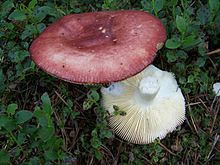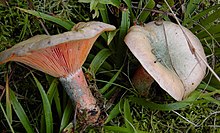Deaf rule








The deaf rule is a mycological guideline to distinguish edible from inedible or poisonous mushrooms of the genera deaf (Russula) and milk ling (Lactarius) in Central Europe.
statement
When chewing small amounts of raw mushroom meat, edible species of the genus Russula and Lactarius , native to Central Europe, taste mild, while spicy and / or bitter tasting species are poisonous and / or inedible.
applicability
The application of Täublingsregel is absolutely requires that the question mushroom unequivocally identified as Milchling or Täubling. Under no circumstances should it be used on other types of mushrooms; Since many poison mushrooms taste mild, there is usually a risk of severe, in the worst case fatal, mushroom poisoning if used incorrectly .
For example, the edible green blubber can be confused with the green capillary mushroom , whose life-threatening poison is not revealed by its heat.
Since all the fungal related fungi, including the milky and the deaf themselves, are mycorrhizal fungi , their occurrence is limited to the immediate vicinity of trees. Mushrooms that do not grow near a tree can therefore be neither deaf nor milkling. For such mushrooms, the use of the deaf rule is excluded without exception.
Security Recommendations
There are several safety tips and a few exceptions that should be observed when applying the blubber rule :
- In areas in which the occurrence of the fox tapeworm cannot be ruled out, samples of raw mushrooms should not be tasted at all because of the risk of infection . Information on this is available from the local forest office .
- Regardless of the result, the sample should not be swallowed, but spit out again after chewing; Even edible mushrooms can cause digestive disorders when raw. An exception to this is the edible patty , for which the pigeon rule applies.
- Only carefully cleaned mushroom samples should be tasted, especially if they are wild mushrooms. Specimens with signs of rot or maggot infestation as well as mushrooms from near roadsides or rubbish dumps are not to be tasted.
- It should be noted that shortly after tasting very hot or very bitter mushrooms, finer differences in taste can no longer be determined, which can temporarily falsify the results of subsequent samples.
Exceptions
- The deafness species Nisekurohatsu (Russula subnigricans), which occurs in Japan and Taiwan, tastes mild or only slightly bitter, so it cannot be reliably identified as poisonous by the deafness rule. Consumption can lead to potentially fatal rhabdomyolysis caused by cycloprop-2-ene-carboxylic acid in susceptible individuals ; the Nisekurohatsu was the only blubber to be recognized as the cause of fatal mushroom poisoning. Therefore, the deaf rule should only be applied to Central European species.
- Certain ravioli and milk lemons , which, like the spruce irritant, only taste slightly bitter or, like the ocher ravioli, only taste spicy in the lamellae, can be edible despite these results, even if not of the best quality. Do not consume other pigeons and milklings with similar or unclear test results.
- Some hot milklings such as the birch milkling as well as the red-brown and olive-brown milkling are consumed in Eastern Europe after repeated soaking, scalding and disposal of the cooking water, while in the rest of the distribution area they are considered to be poisonous mushrooms and are not used in accordance with the deafness rule.
- The mild red-stemmed leather deafness Russula olivacea behaves like an edible mushroom according to the deafness rule and is well tolerated in most cases, but in individual cases it can lead to intolerance reactions similar to poisoning and should therefore be avoided. On the other hand, on the closely related, also mild, white-stemmed leather deafness Russula rommelii , the deafness rule can be applied without hesitation.
Chemical background
Pungent or bitter-tasting deaflings and milklings owe their taste to the fungus poisons velleral and necatoron , which have a mutagenic effect when consumed and lead to severe digestive disorders.
Fungus species subject to the deaf rule
Lists of mushroom species to which the deaf rule applies:
Deafblings
- Category: deafblings (German names)
- Category: Russula (scientific names)
- List of Täublingen (scientific names)
Milklings
- Category: Milchlinge (German names)
- Category: Lactarius (scientific names)
The Milchlingen also includes all irritants . No inedible or poisonous mushroom has become known among them, but there are some tart to bitter-tasting species such as the spruce spruce, whose value as edible mushrooms is low.
The above exceptions and security recommendations must be observed when using the lists and categories mentioned.
Individual evidence
- ↑ a b c d e f Andreas Neuner : Mushrooms. BLV 1982, ISBN 3-405-12048-9 . Pages 106-116
- ↑ Collecting and preparing wild mushrooms: Tips for carefree enjoyment. Stiftung Warentest , September 28, 2015
- ↑ Udo Pollmer : Edible mushrooms can also be poisonous. Deutschlandradio on October 9, 2015
- ^ University of Adelaide : Russula subnigricans.
- ↑ Linda Gail Price: Milkcaps. California Academy of Sciences , October 29, 2014
- ^ Andreas Neuner: Mushrooms. BLV 1982, ISBN 3-405-12048-9 . Pages 114 and 116.
- ↑ Der Tintling : Monograph on Russula olivacea . Their feed value is specified there as 0.
- ^ Gerhard Eisenbrand, Peter Schreier, Alfred Hagen Meyer: Römpp Lexikon Lebensmittelchemie. 2nd edition 2006, Thieme Verlagsgruppe , ISBN 978-3137366027 , page 145
Note
Knowledge and use of the pigeon rule do not replace the general rules for identifying and collecting edible mushrooms.

